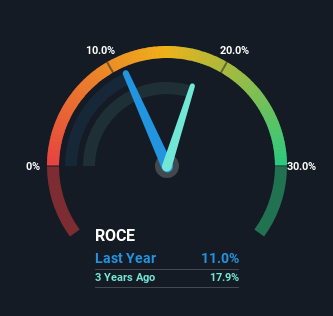The Returns On Capital At Winox Holdings (HKG:6838) Don't Inspire Confidence

To find a multi-bagger stock, what are the underlying trends we should look for in a business? One common approach is to try and find a company with returns on capital employed (ROCE) that are increasing, in conjunction with a growing amount of capital employed. If you see this, it typically means it's a company with a great business model and plenty of profitable reinvestment opportunities. Although, when we looked at Winox Holdings (HKG:6838), it didn't seem to tick all of these boxes.
What Is Return On Capital Employed (ROCE)?
Just to clarify if you're unsure, ROCE is a metric for evaluating how much pre-tax income (in percentage terms) a company earns on the capital invested in its business. The formula for this calculation on Winox Holdings is:
Return on Capital Employed = Earnings Before Interest and Tax (EBIT) ÷ (Total Assets - Current Liabilities)
0.11 = HK$107m ÷ (HK$1.2b - HK$211m) (Based on the trailing twelve months to June 2023).
So, Winox Holdings has an ROCE of 11%. By itself that's a normal return on capital and it's in line with the industry's average returns of 11%.
See our latest analysis for Winox Holdings

Historical performance is a great place to start when researching a stock so above you can see the gauge for Winox Holdings' ROCE against it's prior returns. If you'd like to look at how Winox Holdings has performed in the past in other metrics, you can view this free graph of past earnings, revenue and cash flow.
So How Is Winox Holdings' ROCE Trending?
On the surface, the trend of ROCE at Winox Holdings doesn't inspire confidence. To be more specific, ROCE has fallen from 25% over the last five years. Given the business is employing more capital while revenue has slipped, this is a bit concerning. This could mean that the business is losing its competitive advantage or market share, because while more money is being put into ventures, it's actually producing a lower return - "less bang for their buck" per se.
The Key Takeaway
In summary, we're somewhat concerned by Winox Holdings' diminishing returns on increasing amounts of capital. Long term shareholders who've owned the stock over the last five years have experienced a 54% depreciation in their investment, so it appears the market might not like these trends either. Unless there is a shift to a more positive trajectory in these metrics, we would look elsewhere.
If you'd like to know more about Winox Holdings, we've spotted 3 warning signs, and 1 of them is concerning.
For those who like to invest in solid companies, check out this free list of companies with solid balance sheets and high returns on equity.
Valuation is complex, but we're here to simplify it.
Discover if Winox Holdings might be undervalued or overvalued with our detailed analysis, featuring fair value estimates, potential risks, dividends, insider trades, and its financial condition.
Access Free AnalysisHave feedback on this article? Concerned about the content? Get in touch with us directly. Alternatively, email editorial-team (at) simplywallst.com.
This article by Simply Wall St is general in nature. We provide commentary based on historical data and analyst forecasts only using an unbiased methodology and our articles are not intended to be financial advice. It does not constitute a recommendation to buy or sell any stock, and does not take account of your objectives, or your financial situation. We aim to bring you long-term focused analysis driven by fundamental data. Note that our analysis may not factor in the latest price-sensitive company announcements or qualitative material. Simply Wall St has no position in any stocks mentioned.
About SEHK:6838
Winox Holdings
An investment holding company, develops, manufactures, and sells stainless steel products.
Adequate balance sheet and slightly overvalued.
Market Insights
Community Narratives



